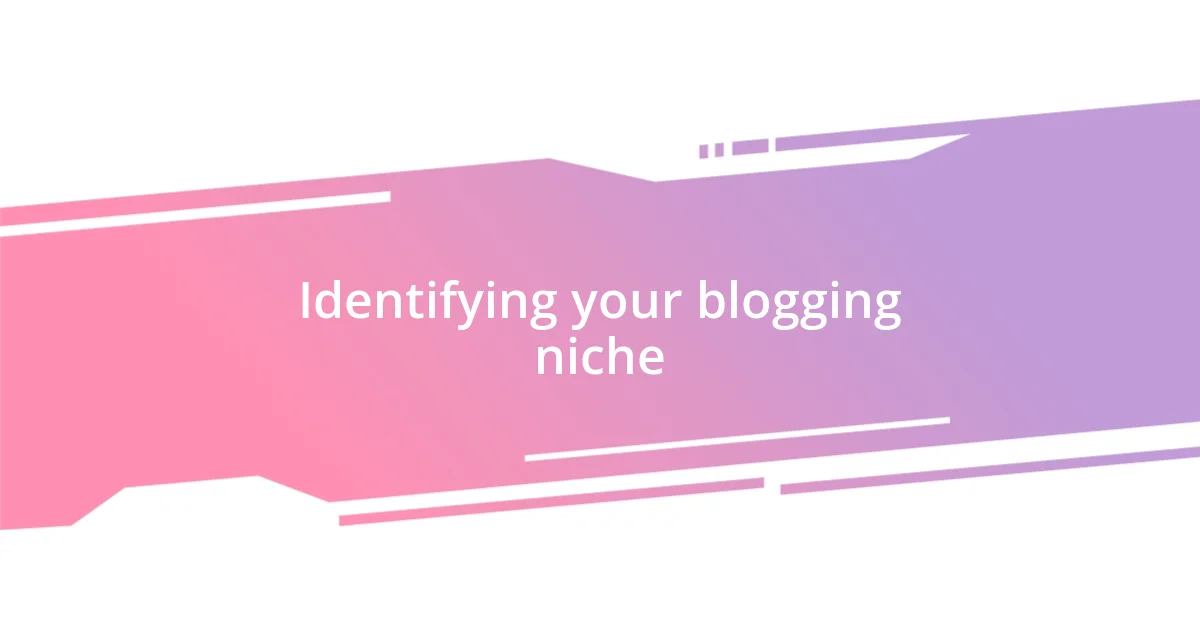Key takeaways:
- Identifying a specific blogging niche allows for authentic expression and community building, enhancing engagement with readers.
- Choosing the right blogging platform is crucial; factors like ease of use, customization, scalability, cost, and support significantly affect the blogging experience.
- Effective promotion through social media, collaborations, and building an email list is essential for reaching and engaging your target audience.

Understanding the blogging landscape
Understanding the blogging landscape can feel like navigating a vast ocean of voices and perspectives. I remember when I first dipped my toes into this world; I was overwhelmed by the sheer volume of content. It made me wonder, with so much out there, how does anyone even get noticed?
Today, blogs can serve many purposes, from personal journals to professional platforms. I’ve seen some bloggers transform their passion into a thriving business. When I realized that blogging could be both a creative outlet and a potential income source, it sparked a fire in me. It feels amazing to think that sharing my thoughts could connect with others and perhaps even impact their lives.
The diversity in the blogging landscape is astounding. Have you ever thought about the niche topics that intrigue you the most? I’ve found that honing in on a specific focus can make all the difference. For instance, I once wrote a post about my journey with self-care, and the feedback was immediate and heartfelt. It reminded me that even in a crowded space, there’s always room for authentic voices that resonate with readers.

Identifying your blogging niche
Identifying your blogging niche is like finding your personal voice in a crowded room. When I started my blog, I tested a few different themes, ranging from travel to cooking. Each attempt was a learning experience, but it wasn’t until I zeroed in on parenting that I truly felt at home. It was as if a lightbulb had gone off; I could speak from my experiences, and my authentic voice finally shone through.
Your niche shouldn’t just be about what you’re passionate about; it should also address specific audience needs. I remember drafting my first post on managing work-life balance as a parent. The engagement was overwhelming! It underscored the importance of marrying personal interests with broader conversations that people actively seek out. This alignment not only attracted readers but also cultivated a thriving community around shared experiences.
Don’t be afraid to iterate on your niche as you grow. Sometimes, our passions evolve, and that’s perfectly okay. For example, after a few months of focused parenting content, I found myself wanting to explore mental health topics within that sphere. While at first, I was hesitant to stray too far from my niche, I realized that my insights on mental health resonated deeply with my audience and expanded my reach. Your niche might also shift as you discover new passions or your audience’s preferences change.
| Factors to Consider | Your Blogging Niche |
|---|---|
| Personal Passion | Ensuring that the topic excites you and you have a vested interest in it |
| Market Demand | Researching what potential readers are searching for |
| Uniqueness | Identifying what makes your perspective special compared to others |
| Target Audience | Understanding who you want to reach and their interests |

Choosing a blogging platform
Choosing a blogging platform is one of the most crucial steps in your blogging journey. I remember staring at my screen, unsure of where to start. With so many options available, it felt a bit like being a kid in a candy store—exciting yet overwhelming. I eventually landed on WordPress, which perfectly balances flexibility and user-friendliness, and it’s been a game-changer for my blog.
Here are some important factors to keep in mind when deciding on a platform:
- Ease of Use: Look for a platform that doesn’t require extensive technical skills. You want to spend time creating content, not fiddling with complicated settings.
- Customization Options: A good blogging platform should allow you to tailor your site’s appearance and functionality to reflect your unique voice.
- Scalability: Consider how easy it will be to grow your blog. Will the platform accommodate additional features or design changes as your audience expands?
- Cost: Some platforms offer free versions while others have a range of pricing tiers. Assess what fits within your budget without compromising essential features.
- Support and Community: A platform with a strong community or customer support can be invaluable as you navigate your blogging journey. Sharing experiences with others can provide encouragement and insights.
These considerations can guide you toward making a choice that suits your blogging goals. Finding the right fit is like meeting a new friend; it should feel natural and supportive as you share your voice with the world.

Essential tools for new bloggers
When I think about essential tools for new bloggers, the first thing that comes to mind is content creation software. For a while, I wrestled with disjointed notes and half-baked ideas scattered across documents. Then I discovered tools like Google Docs and Notion, which revolutionized how I organized my thoughts. Suddenly, I could draft, edit, and collaborate seamlessly with others if I wanted feedback. Have you ever felt overwhelmed by the sheer chaos of untamed ideas? These platforms can really help streamline that process and make your writing flow smoother.
Next up, I can’t understate the importance of a graphic design tool. Platforms like Canva became my best friend in creating eye-catching visuals to accompany my blog posts. In the beginning, I clumsily attempted to create images using complicated software, which often left me frustrated. Canva’s user-friendly interface made designing compelling graphics enjoyable, sparking a newfound creativity I hadn’t tapped into before. Just think about how a beautiful image can elevate your content; it’s like adding icing to a delicious cake.
Finally, let’s talk about analytics tools. I was initially hesitant to dive into analytics, seeing it as a sea of confusing numbers. However, when I finally embraced Google Analytics, I realized it was a treasure trove of insights about my audience. Tracking how readers engaged with my posts helped me refine my content and truly connect with what my audience craved. Have you explored your blog’s metrics? Understanding your audience is like having a compass directing you toward future content that resonates and sparks conversations.

Developing a content strategy
Developing a content strategy is like setting the stage for a performance; it guides the entire process of creating and sharing your thoughts. When I first started, I found myself floundering without direction. I quickly learned that defining my target audience made a world of difference. Who are you writing for? Knowing this not only shapes your content but also infuses it with a sense of purpose.
I remember sketching out a content calendar, which transformed my chaotic ideas into a coherent plan. It felt gratifying to see my posts mapped out, giving me a clear timeline and momentum. This structured approach helped me remain consistent, and I’ve found that regular posting not only keeps readers engaged but also fosters a sense of trust. Have you ever wondered how often to post? From my experience, consistency trumps frequency—quality always outshines quantity.
Lastly, engaging with current events and trending topics in your niche can be a game-changer. I often jot down ideas as they come up in my daily life, capturing moments that inspire me. A quick note on a relevant topic can spark a whole blog post! Have you considered integrating timely discussions into your strategy? I’ve noticed that these timely pieces often resonate deeply with readers, creating a dynamic conversation around my blog, which keeps it fresh and relevant.

Promoting your blog effectively
Promoting your blog effectively takes creativity and a bit of strategy. When I first shared my blog, I relied heavily on social media, but I quickly discovered this wasn’t enough. A friend suggested joining niche online communities, and I was amazed at the engaged responses I received. Have you tapped into spaces where your audience already hangs out? Sharing my content in relevant forums and groups led to authentic conversations and genuine interest.
Another game changer for me was collaborating with other bloggers. I’ll never forget my first guest post; it felt exhilarating not just to pen something for another site, but to connect with their audience too. Cross-promotion can amplify your reach in ways you might not expect. Have you thought about partnerships? These collaborations can introduce your blog to new readers and create a sense of community among bloggers in your field.
Lastly, I can’t stress the value of building an email list enough. Early on, I neglected this aspect and sorely missed out on direct engagement with my readers. When I started offering a free downloadable resource to entice subscribers, I saw my list grow steadily. Do you have a way to connect directly with your audience? This personal touch fosters loyalty, helping to turn casual readers into devoted fans who eagerly await your next post.

Measuring your blog’s success
Measuring your blog’s success may initially seem complicated, but it can be quite rewarding. For me, it started with tracking basic metrics like page views and unique visitors. I remember the excitement I felt seeing those numbers rise for the first time; it was validation that my words mattered. But here’s the key: I quickly learned that not all metrics carry the same weight—engagement and interaction often tell a deeper story.
One day, while examining my analytics, I noticed a spike in comments on a particular post. It hit me then—my readers were not just consuming content; they were connecting with it. How do you measure engagement? For me, the number of comments, social media shares, and email responses became more telling than mere views. This realization shifted my focus from chasing traffic to fostering community, which ultimately enriched my blogging experience.
As I’ve continued to refine my approach, tools like Google Analytics have become essential. I recall feeling overwhelmed by the data at first, but breaking down metrics into manageable insights sparked a newfound enthusiasm. Are you familiar with key performance indicators like bounce rate and session duration? Understanding these can provide clarity on how people interact with your content, enabling you to tune your strategy for better results. Like many things in life, measuring success is often about looking beyond the surface—every number tells a story, and it’s up to us to interpret it.














